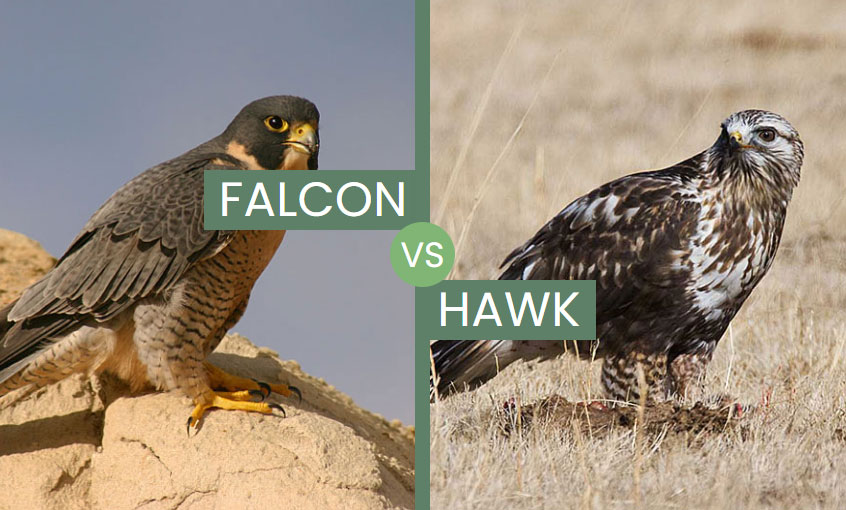Falcons and hawks look similar, but in reality, the two species have several traits that set them apart.
For example, falcons and hawks have different behavior patterns. When comparing falcon vs hawk, they have different flying styles, choose other locations for their nests, and use different body parts to kill their prey.
In this article, we’ll go over both the similarities and differences between these two birds to help you easily identify who’s who.
On this page
Body & Shape
Falcons and hawks are both birds of prey, but that’s where their similarities end.
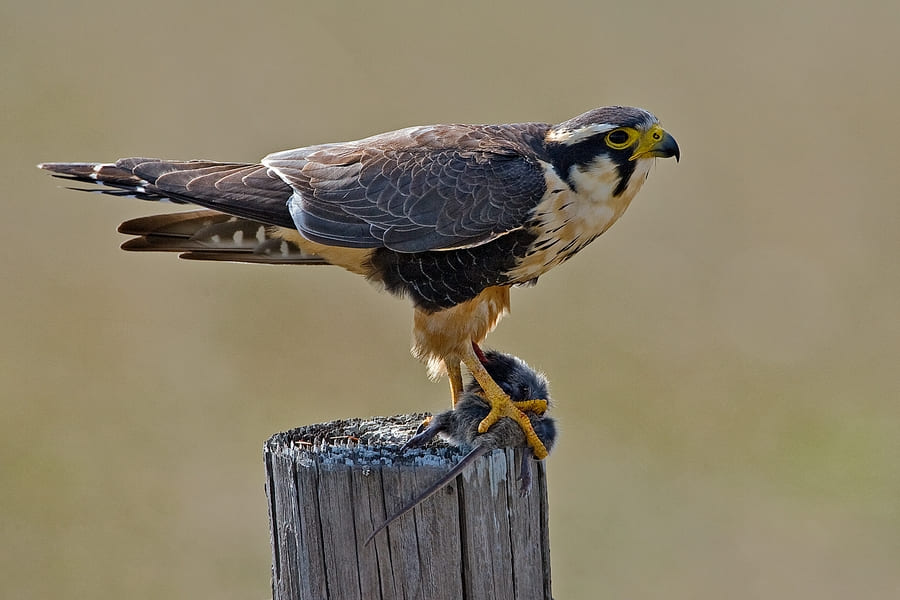
Falcons have rounder heads and pointier wings.
If you happen to see a hawk or a falcon perched, it’s a good idea to note the shape of its head. Falcons have rounded, short heads, while Hawks have pointer heads.
Hawks don’t have the notch at the tips of their beaks that falcons do. Falcons use this notch to kill prey. Instead, hawks have bills that are evenly curved and will use their talons to kill their prey.
Another huge indicator is the wings. Even with a quick look, you can see that hawks have wide, short, rounded wings, and falcons have slender, long, pointed wings. In addition, some species of hawks have feathers that separate on the ends.
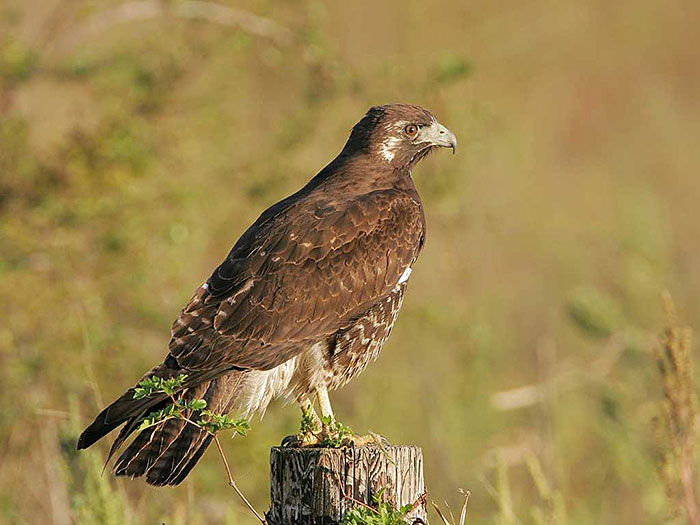
Hawks have an evenly curved bill, and their wings look more seamless when perched.
Falcon vs Hawk Size
The most notable difference between these two birds is their size. In both falcons and hawks, females are larger in size than males.
However, hawks are considered larger overall. They measure anywhere from 8 – 30 inches long. Falcons are petite to medium in size and measure 8 – 26 inches.
Of course, other factors, such as species and age, affect size, but overall, hawks are bigger than falcons.
Speed
Hawks have a larger wingspan than falcons. Hawks glide through the air, flapping their broad wings slowly. They’re known to soar for long periods of time. Falcons float through the air over short distances and flap their wings quickly.
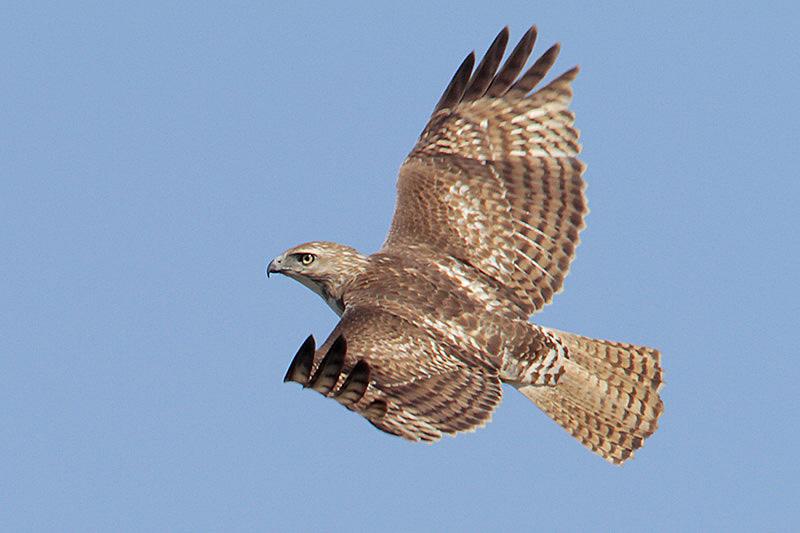
Hawks tend to glide more.
Falcons fly much faster than hawks, even though they have narrower wings. Additionally, their pointed wings and small body shape allow them to fly at high speeds.
Falcons soar at 390 km/h, while a Hawks average speed is 190 km/h.
Age
On average, hawks live longer than falcons. The average lifespan of a hawk is 20 years, while falcons live about 13 years old. Around 60% of falcons don’t survive their first year of life. This means that 6 out of the 10 falcons will not survive their first year. However, falcons and hawks face the same threats in the wild.
Learn more: Bird Facts and Statistics
Of course, both of these birds can live to be a lot older if they remain safe from threats in the wild. In captivity, where proper nutrition is given, and they are safe from all dangers, hawks live up to an average age of 30 years.
Falcon vs Hawk Behavior
Hawks take care of their young until they leave home. So hawks that are in the fledgling stage will leave home for the first time when it reaches 6 weeks old. Then, when the birds reach 8 weeks old, they’ll start hunting. Unlike other birds, including falcons, hawks kill their prey with their talons.
Related: Eagle vs Hawk vs Falcon
Hawks prefer to hunt just before nightfall. However, hawks are not known for being typical vicious hunters; some can be very quiet.
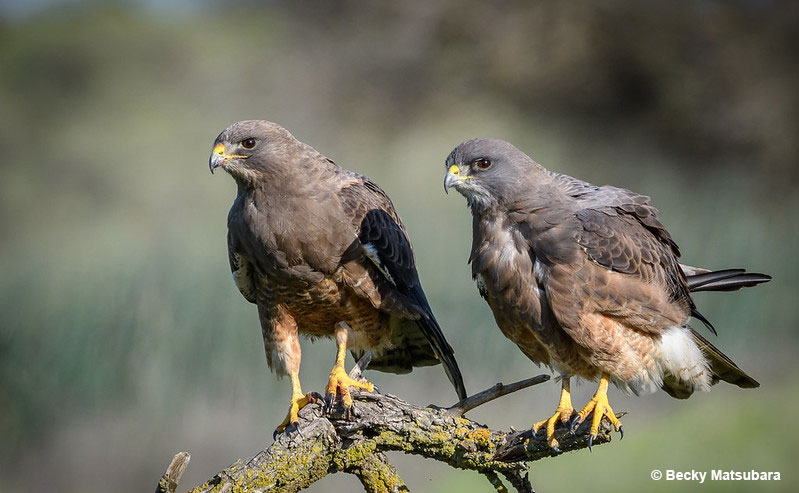
Pair of Swainson’s Hawks. Photograph © Becky Matsubara
Furthermore, hawks flock together during migration, and it’d theorized that birds and other animals flock together to increase their chances of survival. It’s become clear to observers that hawks traveling in flocks have a higher possibility of survival than if they travel solo.
Like most birds of prey, falcons live alone outside of the breeding season. However, some species of falcons will gather near plentiful food sources. These birds rest on high perches and scavenge for food all day long.
Some species, like Peregrine Falcons, also hunt around dusk or dawn in the late evening and early morning. Depending on the region and species, some falcons don’t migrate, while others participate in either complete or partial migrations.
Falcons kill their prey with their beaks instead of their talons, but falcons do use their talons to catch prey.
Falcon vs Hawk Diet
Falcons primarily consume small mammals like rabbits, gophers, squirrels, and rats. They’ll also consume birds such as quails and pigeons. Also, falcons are sometimes known to take down bigger animals like foxes and geese. Falcons are carnivores, meaning they don’t consume plants like many other birds; they only eat meat.
They consume their prey whole, but they’ve also been seen tearing off pieces of the flesh of their prey. Falcons have very sharp talons, which help them kill and dismember their food. Falcons also have a very strong beak with a notch which is ideal for tearing meat.

Both falcons and hawks are vicious birds of prey and are well-known for their hunting styles.
Hawks eat small mammals like rats, gophers, mice, squirrels, chipmunks, and rabbits. They also eat snakes, fish, frogs, insects, and lizards. Hawks are strictly carnivores and will consume anything smaller than them.
Their high soaring ability and sharp eyesight allow them to easily spot prey. Birds of prey are often said to take off with small pets and chickens, but this is very rare.
Location
Falcons can be found all over the world in many different habitats. They reside in all habitats, including wetlands, grasslands, mountains, estuaries, forests, scrublands, taiga, and even the desert and the Arctic tundra. Some species of falcons flourish in urban settings, such as parks, farms, crowded cities, and gardens.
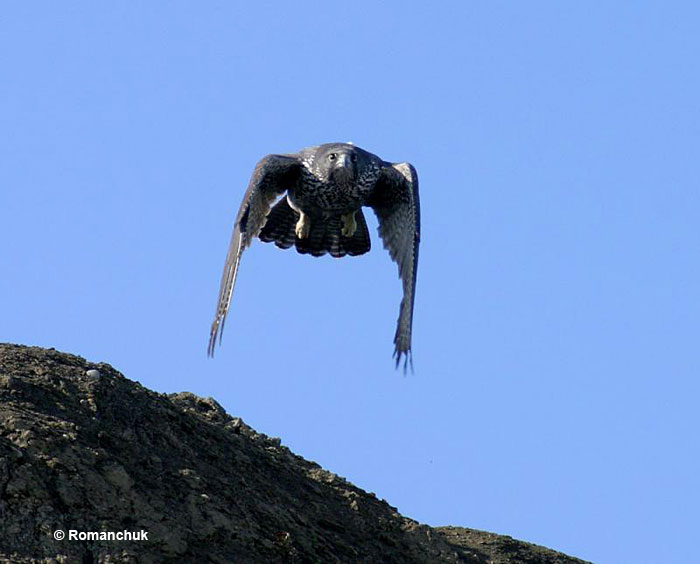
Hawks are birds that can easily adapt to all of their surroundings. In fact, past research has shown that these birds prefer open habitats.
They often prefer to inhabit areas like fields and deserts because these areas are easier to find prey in. They are also found in humid, tropical regions as well as mountainous plains.
These birds can survive nearly everywhere.
Nest & Eggs
Hawks commonly build their nests on the branches of tall trees where they have a wide view of the airy landscape around them. They’ve even been known to build their nests on billboard platforms, cliffs, chimneys, and window sills.
Alternatively, falcons will often build their nests on tall cliffs like in the Grand Canyon. These birds have even been known to use abandoned nests of other big birds in trees, bridges, and buildings.
Falcons don’t bring any materials to create their nests. Instead, the female falcon will pick a nesting site and uses its foot to make a shallow hole in the sand or on the ground. Additionally, falcons will often gather on top of mountains and hills.
Every year, female hawks will lay anywhere from 1 to 5 small eggs that are greenish-white. It takes anywhere from 28 to 32 days for these eggs to hatch. Hatching occurs in the early spring from March to May, which is after the mating season.
Falcons have a similar egg-laying process that hawks do. However, falcon eggs are not the same color as hawk eggs. Falcon eggs can be anywhere from pink to reddish-brown. Additionally, they’re a little bit smaller than chicken eggs. Both parents will participate in the incubation process, which lasts around a month.
Frequently Asked Questions about Falcon vs Hawk
What is the difference between a falcon and a hawk?
Falcons and hawks have many differences. They’re not the same size and have different behaviors, wing shapes, colors, and habitats.
Which is bigger hawks or falcons?
Size is a notable difference between these birds. Falcons are smaller than hawks but have larger wingspans. However, we would like to mention that size is not enough to identify whether a bird is a falcon or a hawk. While falcons tend to be smaller than hawks, there are small hawks and large falcons.
Which is more powerful hawk or falcon?
Falcons are smaller and faster than hawks, but hawks and stronger and more powerful.
Are falcons in the hawk family?
No, falcons are not in the Hawk family. Both of these birds are birds of prey, but falcons are in the Falconidae family, and hawks are in the Accipitridae family.

